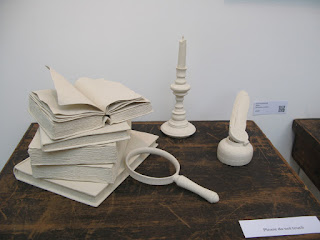I will show my works that were thrown by various body parts at the same level of these parts.
5/28/2015
5/13/2015
Research cabinets
5/12/2015
Market Research - COLLECT 2015-
I visited COLLECT 2015 in saatchi gallery to research the craft market.
The number of works that focus on glazes is small. There are a lot of no glaze porcelain and clear glazed porcelain.
This work made by Rupert Merton was similar to my pots. He showed many pots in the cabinets. His display way and pricing would be good reference for me.
5/11/2015
Dulwhich Artist Festival 2015
I took part in the Dulwhich Artist Festival 2015, I displayed my miniature pots in Tom&Ingrid Beazly House. I sold many miniature pots and got a lot of customer's opinions.
This was a very useful time to understand customer's preference, for example colour, forms and size of miniature pots. also I got a lot of information about market of ceramic and miniature, for instance shops or people who like miniature things.
Talking with customers give me good opinions and inspiration. I am going to take part in this kind of exhibitions as much as I can in the future.
5/01/2015
Indian pottery -throw by the same motion and apply the same amount of pressure-
The proposal for the study tour of Indian pottery.
I am currently researching the relationship between the human body and
art in the field of craft. In India, there is a tradition of drinking chai in disposable biscuit
cups. To
accommodate this practice, a large amount of biscuit cups is made every day.
The goal of this trip is to observe the production process of chai cups around Kolkata, to gather inspiration and
incorporate it into my practice.
In the production of these cups, Indian potters throw them quickly on the
wheel, creating approximately three cups per minute.
They make cups of a similar size and shape not by using tools to measure, but rather by their hands. They throw by the
same motion and apply the same amount of pressure. It is an amazing technique
that reveals one of the ways in which the human body and artwork are related in
the creation process. Moreover, they use no tools to make the cups’ surface smooth, so their hands
mark the surface of each cup. This illustrates another aspect of the
relationship between the human body and artwork. This practice is expected to
be an important research object.
I
have proposed a ten-day journey. While this may seem a bit long for only one
city, it is justified by the complexity of the practice. I would like to see
the entire process, from the digging up of the clay to the firing of the cups.
Chai cups are made of local clay and fired at very low temperatures, a unique
and remarkable
characteristic.
This
trip to the field is expected to give me great inspiration as I explore new
relationships between the artist’s body and artwork. I want to find out innovative contact ways with
clay through this trip.
Subscribe to:
Comments (Atom)














